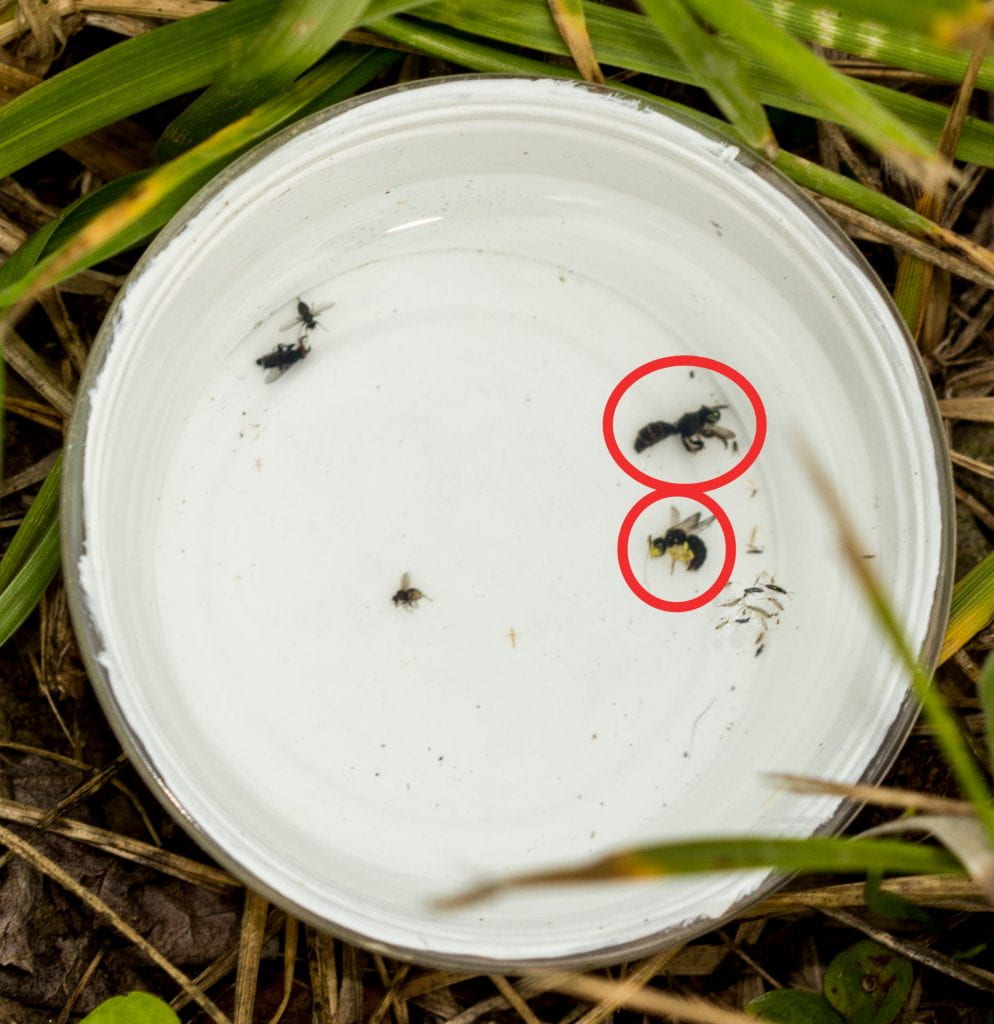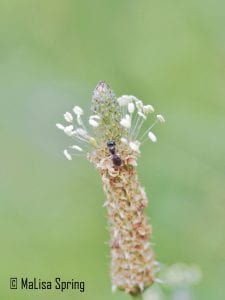Collection kit sampling reminder: For those of you with collection kits, this is your reminder to try to put out your traps sometime this week. Be sure to wait at least 7 days from your last sampling. So if you set your traps on Saturday, you need to wait until next Saturday before considering whether to trap again.
Check the weather for your part of Ohio for the day you hope to sample. Note that weather predictions past 3 days tend to be pretty iffy, so check the weather forecast regularly. If the forecast looks like it is more than a 25% chance of rain, do not sample on that day.
If you can no longer put out your collection kit, please let me know so we can work on getting the kit into the hands of another volunteer instead.
Bee facts of the week:
- Dull Green Sweat Bees (Lasioglossum [Dialictus] spp) are bees in the subgenus Dialictus, which are in the genus Lasioglossum. This genus is extremely diverse, with almost 100 species thought to occur in Ohio. There are other subgenera of Lasioglossum, but they aren’t as common. Dull Green Sweat Bees are also the ones that are known to land on people to drink their sweat. They are getting vital minerals by doing so, but are at risk of being swatted by us. They will generally drink the sweat and fly away, but if they get caught in a crease (say behind your knees or inner part of your elbow), they might sting out of fear of being squashed. Most nest in the ground and have been occasionally found to nest in the soil of flower pots as well. Almost all bees in the genus Lasioglossum are thought to be generalist foragers, meaning they are found collecting pollen from many different plant groups. There are three floral specialists in the genus Lasioglossum on Jarrod Fowlers website, but they are not in the subgenus Dialictus.
ID tip of the week:
- Dull Green Sweat Bees (Lasioglossum [Dialictus] spp) are small bees with a slightly green metallic tint. They are most often confused with Small Carpenter Bees (Ceratina spp), which are less hairy and tend to be a darker metallic blue/green instead of the lighter olive green (but this all depends on lighting too). The Dull Green Sweat Bees will never have hair bands at the end of the abdominal segments, but might have patches of hair at the base of their abdominal segments instead. The positioning of hair bands can also differentiate them from the genus Halictus.

Note the particular green reflective tint along with the lack of a distinct hair band along the edge of the abdominal segments.
- Sometimes other small insects or arthropods also land in our traps. Although they are not our intended focus of this project, I will try to give a little bit of info about different groups we might see in our traps. So hopefully you learn a little entomology along with all of our awesome bee knowledge. If you want a specific group covered that you are seeing a lot of in your traps, let me know!

The bowl looks mostly empty, right? But if you look really closely, you can see a couple specks here and there.
- This week, I want to highlight Thrips! Like the Springtails we covered in the first week, Thrips are tiny specks that are easily overlooked in traps. I had several in my bowls this week that looked like little grass anthers.

Because they are so small, thrips can be hard to photograph. They are especially hard to photograph in water, where the slight diffraction causes them to not be as sharp as if I had photographed them on a plant.
- Thrips are in the Order Thysanoptera and can be plant pests, though there are several subgroups that specialize on weird food sources such as fungi, leaf litter, or other insects. We have an estimated 700 described species of Thrips in North America, though they are so small that they are easily overlook. There are another 200 undescribed species in North America that taxonomists are presumably still working on writing up. Thrips are typically really small and often either black, black and white, or yellow. There are winged and wingless species, but those that do have wings have distinct fringed edges, assuming you can get enough magnification to see the fringes. See more info on thrips here: https://bugguide.net/node/view/7754
Is that a bee?
- In this brief section, I will show a photo of a bee bowl and let you guess how many of the insects are actually bees. Don’t worry about properly identifying bees in your bowls for now. This is just so you can start to recognize some of the bees during the season and get an idea of how many bees you actually have.
.
.
.
.
Okay, did you make your guesses?

There are two bees in this bowl! This time, we have a male and a female Calliopsis andreniformis, which were our bee ID tip of the week last week. There are also some flies and springtails.

And remember the first week where I talked about springtails? Well, I had a lot of them floating on the top of the water this week. Here is a hodge podge of several types of springtails that are stuck in the water. They are so small they can’t break the surface tension of the water and instead float on the top!
And that is all I have for you this week. May the weather cooperate for your sampling and may you stay safe.
Best wishes,
MaLisa


MaLisa, I am out of town this week. I can’t set out the traps this week, but will be back and set them out next week. Helen Hollis, Sandusky County nty
Hi Helen,
That’s fine, we have wiggle room with sampling dates and skipping weeks. Have a safe trip! Hopefully you see some cool bugs wherever you are going.
-MaLisa
MaLisa….I will not be putting my bowls out this week because rain is predicted every day…..I will keep watch on weather just in case there is a break. I really like to read your blog posts about your catch and by-catch in your bowls. Learning a lot about bees and other insects this summer. Thank you!
Hi Karen,
That is fine. We anticipated weather causing people need to skip a few weeks. Plus a lot of Ohio really needed the rain we are getting now. I got 150 gallons of water in my rain barrels out of the short storm yesterday, so I am happy with that.
I’m glad you like the posts! I hope people are getting some use out of them
Best regards,
MaLisa
I missed the first two weeks because of rain but have done the last three Saturdays in a row. This has been enjoyable and I look forward to seeing what in the the bee bowls each week!
Question… Who is collecting in Fairfield County? I work for Fairfield County Park District and one of our naturalists asked who was collecting in the county. (I am collecting in Perry County).
Hi Kimber,
We only got one person to sign up for Fairfield county, so they are sampling at Blacklick Metro Park on the Fairfield side of the park (since the park is in two counties). I haven’t been giving out names of collectors for privacy reasons, but they are free to respond if they wish.
Best regards,
MaLisa
oh, I understand re privacy. Thank you.
If you want someone to sample in Fairfield County, I am sure one of our Naturalists would be happy to do so. Let me know…
Thanks! At this time, we are out of supplies for additional kits, so we cannot add more sites.
While setting out bowls yesterday we “found” a bumble bee nest.
Unfortunately we found it by disturbing it…its residents were not happy.
We got away with only a few stings. Funny now, but not then!
We ran away but they would not shake off easily and they chased us quite farther than one would expect. I am glad no one was there to video our panicked yelling (maybe a few unfortunate words).
We tried to take a few pics but only got blurry grass.
Interestingly, the nest was absolutely invisible.
Maybe we have earned some sort of badge in our study of bees.
Oh no! I am glad you are okay! I’d move your transect a bit next time to hopefully reduce the chance of coming across them again. If you can move it to the left or the right about 10 meters that should help.
I’ve seen bumblebee nests, but they were always docile and let me approach. Though I also didn’t step on their entryway, so if that was the case their reaction might have been different.
I have been putting a bowl in the exact same space for the past few weeks. This week we tried to trim away some weeds…We did move our transect just as you advise!
Sorry you were stung but glad it wasn’t hornets!
Thanks. Me too!